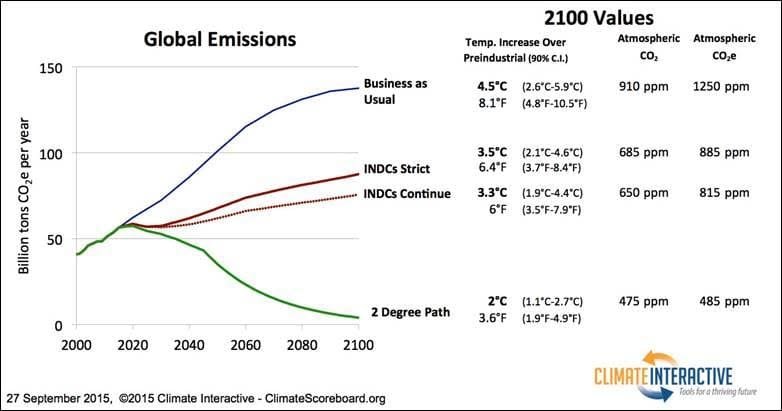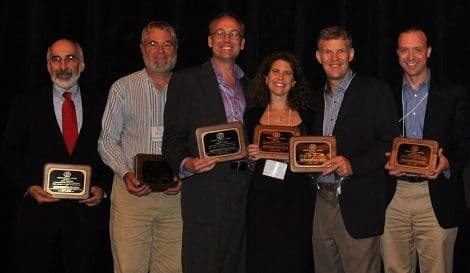How to Understand Climate Change Policies with C-ROADS
The Dynamics of Climate Change: Understanding and influencing the planet’s future (October 8, 2013)
Presented by Andrew Jones, Co-Director, Climate Interactive
Presentation slides: Dynamics of Climate Change slides
Description: Learn how world leaders are using C-ROADS in global climate negotiations C-ROADS is an award-winning computer simulation that helps people understand the long-term climate impacts of policies designed to reduce greenhouse gas emissions. World leaders are using the model in global climate negotiations. In this interactive session, Andrew Jones, Co-Director of Climate Interactive, introduces participants to C-ROADS and describes how it can be used by others to understand and test their own scenarios or conduct real-time policy analysis. This webinar is the first in the Big Data, System Dynamics, and XMILE webinar series jointly sponsored by IBM, isee systems, and the OASIS XMILE Technical Committee.
The Official Website
climateinteractive.org is the official website that covers all information about this brilliant project including the latest news, simulators and learning tools, videos, etc.
The Issue You Tackled
Negotiations have failed even though scientific understanding of climate change and the risks it poses ha s never been stronger. The failure of global negotiations can be traced to the gap between the strong scientific consensus on the risks of climate change and widespread confusion, complacency and denial among policymakers, the media and the public.
What You Actually Did
The C-ROADS model is designed to address these issues and build shared understanding of climate dynamics in a way that is solidly grounded in the best available science and rigorously non-partisan, yet understandable by and useful to non-specialists, from policymakers to the public.
The Results
C-ROADS:
-
tracks GHGs, including CO2, CH4, N2O, SF6, halocarbons, aerosols and black carbon;
-
distinguishes emissions from fossil fuels and from land use and forestry policies;
-
allows users to select different business-as-usual (BAU) scenarios, or to define their own;
-
enables users to capture any emissions reduction scenario for each nation portrayed;
-
reports the resulting GHG concentrations, global mean temperature change, sea-level rise, ocean pH, per capita emissions and cumulative emissions;
-
allows users to assess the impact of uncertainty in key climate processes;
How to Work With The Model?
Video tutorials are available online to guide use
| Name | Climate Rapid Overview And Decision Support |
|---|---|
| Modelers | John Sterman, Thomas Fiddaman, Travis Franck, Andrew Jones, Stephanie McCauley, Philip Rice, Elizabeth Sawin, and Lori Siegel |
| Model | To get the model, please follow this link. |
| Client/Participant | Please click here. |
| Client Type | NGO |
Related Publications
| Climate interactive: the C-ROADS climate policy model. | Download |
| Management flight simulators to support climate negotiations | Download |
| Communicating climate change risks in a skeptical world | Download |
| The Climate Scoreboard shows the progress that national contributions (INDCs) to the UN climate negotiations will make assuming no further action after the end of the country’s pledge period (2025 or 2030). | Scoreboard |
| World climate: a role-play simulation of climate negotiations | Download |
A Big Boost for the Climate Summit
An editorial in the New York Times about the climate summit in Paris, mentions C-ROADS team analysis of Intended Nationally Determined Contributions (INDC). Please follow this link to read this article in the NYT.
Offers for Paris Climate Talks Would Reduce Warming by 1°C
Climate Interactive’s Climate Scoreboard analysis, produced in partnership with the Massachusetts Institute of Technology Sloan School of Management (MIT Sloan), shows that the intended nationally determined contributions (INDCs) put forward in advance of the UN climate talks this December make a sizeable contribution towards curbing global emissions and limiting warming. However, the offers need to be paired with further action if warming is to be kept below the 2°C target, avoiding the worst impacts of catastrophic climate change. Please see the full news release of their new analysis of the expected impact of the emissions pledges nations have made in the run up to Paris. The climate scoreboard is an embeddable widget that people can embed on their sites, blogs, etc. and will automatically update as analysis is revised when new pledges come in. The New York Times and in Science Magazine Science Insider (dated September 28, 2015) have pick up this story so far.
Climate Interactive announced the World Climate Project at a Back-to-School Climate Education Event at the White House.
The World Climate Exercise is a role-playing simulation game that puts teams, classrooms, and communities into the role of international climate negotiators to create a pathway to solutions that limit global warming. Through these simulation games, Climate Interactive plans to reach more than 10,000 people by December 2015, when nations will come together to finalize a global agreement on climate change in Paris. (Aug 2015)
Professor John Sterman and Climate Interactive featured in film “Disruption”
The film Disruption features incredible and informative interviews from scientists, activists and leaders—including Climate Interactive partner John Sterman of MIT. The film was released in advance of the People’s Climate March, the largest climate march in history, in the streets of New York City on September 21, 2014. (September 2014)
System Dynamics Application Award
The System Dynamics Applications Award is presented by the Society every other year for the best “real world” application of system dynamics. The Society awarded its 2013 Applications Award to John Sterman, Thomas Fiddaman, Travis Franck, Andrew Jones, Stephanie McCauley, Philip Rice, Elizabeth Sawin and Lori Siegel for their work Climate Interactive: The C-ROADS Climate Policy Model. To see the citation that was made by Brad Morisson at the conference, please follow this link. (Jul 2013)
Professor John Sterman wrote an article in Climate Progress
It’s a great short article by John Sterman articulating why it is crucial to “hold our feet to the fire” WRT +2C maximum global warming target (i.e., to promote carbon emissions mitigation), while being careful, skeptical and perhaps even averse to climate resilience initiatives (i.e., to avoid engaging in adaptation to climate change). This article is contemporary, and more relevant as each day passes by without a global commitment to limit climate damage to a level that adaptation becomes pertinent. Please follow this link to find the article. (Jul 2013)
OTHER SUCCESSFUL APPLICATIONS
System Dynamics Helps Farmers Escape Poverty Trap in Guatemala
System Dynamics Helps Farmers Escape Poverty Trap in Guatemala EXECUTIVE Summary Guatemala holds the 4th highest global ranking for chronic malnutrition, and climate change is intensifying the challenges subsistence farmers face in providing food for their families....
Twinings Uses System Dynamics Games to Enhance HR Capability
Twinings Uses System Dynamics Games to Enhance HR Capability “Realistic simulation is a powerful approach to building capability. The business simulation developed [by Dashboard Simulations and Lane4] gave [Twinings staff] an experience that called for them to develop...
RSC Uses System Dynamics to Increase HVACR Sales Against the Tide
RSC Uses System Dynamics to Increase HVACR Sales Against the Tide “Using the proven Strategy Dynamic process focused our limited resources on organizing strategic issues, identifying the critical resources, and developing the insight to more rapidly create intuitive...
Upcoming Events
Webinar on Systemigrams
Have you ever wondered how we could tell a clearer story about complex systems and problems? Are you looking for a tool that can help you navigate and analyze intricate systems more effectively? If so, this webinar is for you. The South African System Dynamics Chapter...
Recent Posts
A Digital Twin Business Model in 40 Hours
A Digital Twin Business Model in 40 Hours Though long past the date when I should have ‘retired’, I just can’t resist interesting projects, like the one a new friend brought me a few weeks ago. It concerns a small but fast-growing B2B business,...
2023 PwC Mark Paich Hackathon Highlights
2023 PwC Mark Paich Hackathon Highlights The System Dynamics Society and PwC US joined forces to hold a hackathon event that brought together practitioners, researchers, and students passionate about the System Dynamics methodology. The 2023 PwC Mark Paich Hackathon...
A Close-Up on Our New Look
A Close-Up on Our New Look We are excited to reveal our new logo and branding, embodying the System Dynamics Society’s values and vision for the future. The looped arrows with an S curve symbolize growth, change over time, and commitment to raising complex...
Join us
OTHER SUCCESSFUL APPLICATIONS
System Dynamics Helps Farmers Escape Poverty Trap in Guatemala
System Dynamics Helps Farmers Escape Poverty Trap in Guatemala EXECUTIVE Summary Guatemala holds the 4th highest global ranking for chronic malnutrition, and climate change is intensifying the challenges subsistence farmers face in providing food for their families....
Twinings Uses System Dynamics Games to Enhance HR Capability
Twinings Uses System Dynamics Games to Enhance HR Capability “Realistic simulation is a powerful approach to building capability. The business simulation developed [by Dashboard Simulations and Lane4] gave [Twinings staff] an experience that called for them to develop...
RSC Uses System Dynamics to Increase HVACR Sales Against the Tide
RSC Uses System Dynamics to Increase HVACR Sales Against the Tide “Using the proven Strategy Dynamic process focused our limited resources on organizing strategic issues, identifying the critical resources, and developing the insight to more rapidly create intuitive...
Recent Posts
A Digital Twin Business Model in 40 Hours
A Digital Twin Business Model in 40 Hours Though long past the date when I should have ‘retired’, I just can’t resist interesting projects, like the one a new friend brought me a few weeks ago. It concerns a small but fast-growing B2B business,...
2023 PwC Mark Paich Hackathon Highlights
2023 PwC Mark Paich Hackathon Highlights The System Dynamics Society and PwC US joined forces to hold a hackathon event that brought together practitioners, researchers, and students passionate about the System Dynamics methodology. The 2023 PwC Mark Paich Hackathon...
A Close-Up on Our New Look
A Close-Up on Our New Look We are excited to reveal our new logo and branding, embodying the System Dynamics Society’s values and vision for the future. The looped arrows with an S curve symbolize growth, change over time, and commitment to raising complex...
Upcoming Events
Webinar on Systemigrams
Have you ever wondered how we could tell a clearer story about complex systems and problems? Are you looking for a tool that can help you navigate and analyze intricate systems more effectively? If so, this webinar is for you. The South African System Dynamics Chapter...
Modeling for Impact in the Era of Big Data
Modeling for Impact in the Era of Big Data
On the occasion of the field’s 50th anniversary, in 2007, Jay Forrester spoke to us (SDR 23:359-370) about prospects for the field of System Dynamics—his view of the situation summarized by the phrase “aimless plateau”. He lamented our “slight impact” in government and placed the blame primarily on our failure to ask the big questions, to write books to influence the public (in the tradition of Urban Dynamics, World Dynamics, and The Limits to Growth), and to maintain rigor rather than “dumbing down” our models with “unwise simplification”.
In calling for courage and rigor in SD modeling, Jay was echoing the words of Dana Meadows and Jenny Robinson more than 20 years earlier, in “The Electronic Oracle” (Wiley 1985).
Meadows and Robinson added a third component that they felt was critical for having influence in the public sphere, namely working collaboratively with other researchers and influencers.
Jay, Dana, and Jenny all hoped and believed that, if only we acted with quality and high purpose, the unique attributes of SD modeling would emerge and ultimately be recognized as more powerful than the intrinsically limited modeling paradigms of statistics, econometrics, and input-output analysis.
I have to admit I’m not so sure. Looking at the world of modeling today and who has influence, I’m struck by how statistical approaches still seem to have a strong hold on much of public policy—whether the subject is climate change economics, sustainable development goals, or even the (obviously dynamic and nonlinear) COVID-19 pandemic. There are some exceptions, such as the Forrester award-winning work by Thompson and Tebbens on polio eradication, but such examples of strong SD public policy impact in recent years are few and far between.
Consider, for example, climate change and its likely damages for the global economy. The prominent Yale economist William Nordhaus (a vocal opponent of SD since the 1970s) first published work in this area in 1991, and in 2018 was awarded the Nobel Prize for it. Yet, this econometric work is surprisingly narrow in its outlook, with its damage estimates biased downward, as described by the Australian economist Steve Keen in his recent article, “The appallingly bad neoclassical economics of climate change”.
It doesn’t necessarily require an SD model to overcome some of the shortcomings of the Nordhaus work. An influential study from 2015 is also statistical, but looks at data not only cross-sectionally across many geographical locations (as Nordhaus does) but also longitudinally across 50 years (1960-2010). This study’s estimates of economic damages over the next several decades are at least ten times greater than those of Nordhaus. This longitudinal analysis does not shy away from data but dives further, and more productively, into it.
Conclusions? First, it seems to me that if one is hoping to impact public policy these days, it is important to draw from a large number of cases across diverse locations—the more the better. This is the era of Big Data, after all, and your model needs to be calibrated and applied to many separate cases to prove its worth if you want to influence the public conversation.
A good recent example is a study of the effect of weather and air pollution on COVID-19 transmission. This collaboration between SD modelers and quantitative health scientists drew from data on more than 3,700 different locations around the world, and it garnered significant public attention.
Second, I think we should emphasize our ability to work with longitudinal data. We know (more than most statisticians and economists do) how to move from longitudinal data to properly estimated parameters, and how to situate these parameters within robust dynamic models.
Of course, we should always remember the importance of courage, rigor, and collaboration in modeling. But, these days, to be heard widely in the public forum we must also employ both cross-sectional and longitudinal data and calibrate our models to many individual cases when possible.
Recent Posts
A Digital Twin Business Model in 40 Hours
A Digital Twin Business Model in 40 Hours Though long past the date when I should have ‘retired’, I just can’t resist interesting projects, like the one a new friend brought me a few weeks ago. It concerns a small but fast-growing B2B business,...
2023 PwC Mark Paich Hackathon Highlights
2023 PwC Mark Paich Hackathon Highlights The System Dynamics Society and PwC US joined forces to hold a hackathon event that brought together practitioners, researchers, and students passionate about the System Dynamics methodology. The 2023 PwC Mark Paich Hackathon...
A Close-Up on Our New Look
A Close-Up on Our New Look We are excited to reveal our new logo and branding, embodying the System Dynamics Society’s values and vision for the future. The looped arrows with an S curve symbolize growth, change over time, and commitment to raising complex...
Upcoming Events

2024 Conference Author Registration Deadline
Authors who are designated presenters for the International System Dynamics Conference are required to register for the conference by today. Submissions without a registered author will be removed from the...
Recent Business cases
System Dynamics Helps Farmers Escape Poverty Trap in Guatemala
System Dynamics Helps Farmers Escape Poverty Trap in Guatemala EXECUTIVE Summary Guatemala holds the 4th highest global ranking for chronic malnutrition, and climate change is intensifying the challenges subsistence farmers face in providing food for their families....
Twinings Uses System Dynamics Games to Enhance HR Capability
Twinings Uses System Dynamics Games to Enhance HR Capability “Realistic simulation is a powerful approach to building capability. The business simulation developed [by Dashboard Simulations and Lane4] gave [Twinings staff] an experience that called for them to develop...
RSC Uses System Dynamics to Increase HVACR Sales Against the Tide
RSC Uses System Dynamics to Increase HVACR Sales Against the Tide “Using the proven Strategy Dynamic process focused our limited resources on organizing strategic issues, identifying the critical resources, and developing the insight to more rapidly create intuitive...










